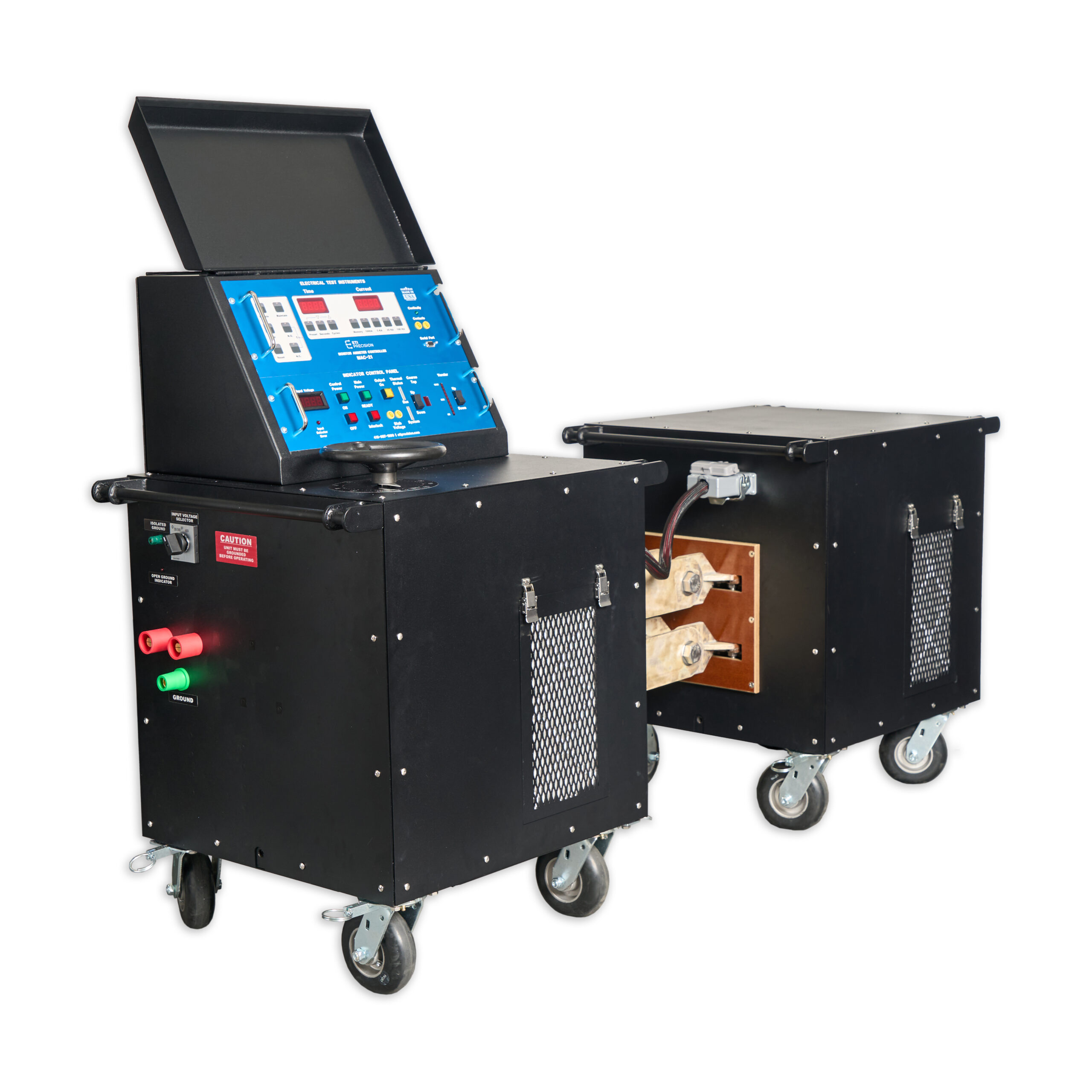
The PI-5000 Gen2 is a two-piece rugged primary injection circuit breaker tester for 4,000A breakers. Its primary applications are for testing low-voltage molded-case and metal-clad AC circuit breakers. The unit may also be used for high-current applications such as ratio transformers and heat runs. The PI-5000 runs on 480VAC inputs. This unit maximizes portability for a very powerful tester through its modular design, allowing it to fit into tight spaces or be lowered into shafts.

The PI-5000 Gen2 is composed of the PI-2500 Gen2 and the AUX-5000 auxiliary output unit, which when combined gives the unit the capability of testing 4000 ampere breakers, with essentially the same specifications as the proven PI-4000B. The auxiliary unit is smaller than the PI-2500 Gen2, so it can also be maneuvered easily in tight spaces, or lowered into shafts and manholes that would not be possible with a larger single piece unit.
The AUX-5000 enclosure is easily attached to the PI-2500 Gen2 output stabs by means of horizontal bus bars with stainless steel socket head cap bolts and sturdy nut plates. The AUX-5000 enclosure is simply rolled into place to mate with the PI-2500 test set, and then the cap screws are tightened. It is recommended to use a stubby fine pitch ratchet wrench or a pneumatic air ratchet, with an allen wrench hex bit.
The main electrical power and ground connections to the AUX- 5000 are the same twist-lock connectors as those on the PI-2500 Gen2. Power cables attached and stored in a compartment in the AUX-5000 are then connected to the PI-2500. The connectors are color-coded for proper connections to be connected with black to black and red to red.
There is also a control cable with easily twist lock quick connectors which connects from the AUX-5000 to the PI-2500 Gen2.
The output of the AUX-5000 accommodates standard breaker stabs, for continuous output of 4000 amperes. It can also be configured in series mode for a continuous output of 2000 amperes. The configuration switch on the PI-2500 Gen2 must be set to 4000 or 2000 for proper output readings.
The combined unit, known as the PI-5000, can only be used on 480 VAC.
This test set will test low-voltage, molded-case and metal-clad, direct acting AC circuit breaker from various manufactures. The test set
can also be used on high current applications like ratio transformers, and heat runs. Using SCR’s the PI-5000 eliminates closing time errors. Initiation at the zero crossover point eliminates DC offset in the current waveform and results in accurate, repeatable test results even with short-duration currents for high speed solid state or electromechanical trip devices. The reduced length and width of the test set allows it to be maneuvered in tight spaces and it can be lowered into a shaft 26” x 30”, or a manhole 40” diameter. Provisions have been made on the bottom of the frame for a lifting sling to be attached without slipping from the corners. The rugged silver plated copper stab adaptors supplied with the test set are designed to be used for both vertical and horizontal stabs, and have both ½” and ¾” output plates.
Serial port: This standard serial port may be connected to a printer, computer, or other device to print or store time and current values of test results in ASCII format. It is set for 9600 baud, 8 bits, 1 stop bit, no parity. This interface enables you to download data into various computer software programs.
Initiating Control: The advance initiate circuitry provides both pulse preset modes for cycles or seconds for output duration. The pulse mode automatically pulses the output to any preset programmed duration. This provides additional testing capabilities
for electromechanical and solid state trip devices. A short preset pulse duration also allows for instantaneous tripping without preheating the breaker under test. A long preset time can used for heat runs on cables or other devices up to maximum 990 seconds.
Zero DC Offset: Use of digitally controlled SCR’s instead of a contactor to initiate the output of the test set eliminates closing time error and thereby ensures precise initiation at the zero crossover point of the output current waveform every time. Initiation at the zero crossover point ensures symmetrical output current by eliminating DC offset in the current waveform. Therefore accurate, repeatable test results are assured even with currents of very short duration, as when conducting tests of instantaneous or short delay trips.
